Focus on Restoration: The Marble Doctor VA, LLC
by Peter J. Marcucci
Photos Courtesy The Marble Doctor
Mouse over photos for captions
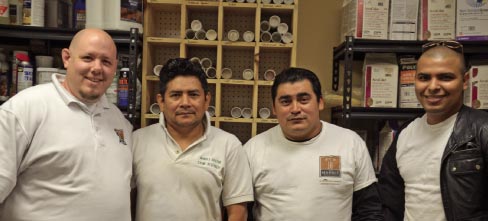 Hey fabricators: Ever wonder what happens after you’ve installed natural stone? The restoration industry is often called upon to bring stone ranging from private spaces to national treasures back to full glory, and in the case of public spaces, restore and maintain them for all to use and enjoy.
Hey fabricators: Ever wonder what happens after you’ve installed natural stone? The restoration industry is often called upon to bring stone ranging from private spaces to national treasures back to full glory, and in the case of public spaces, restore and maintain them for all to use and enjoy.
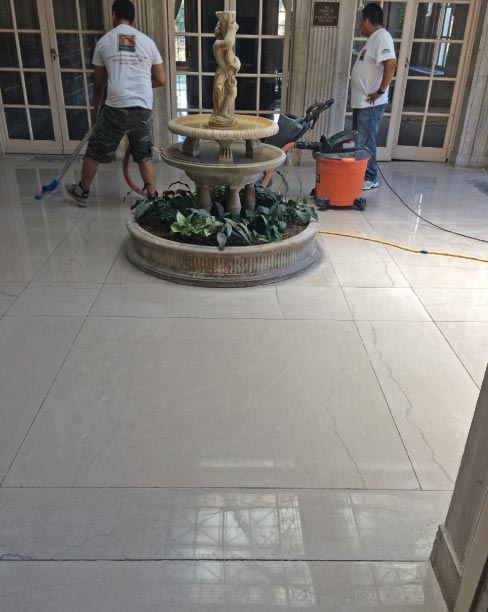 Enter The Marble Doctor VA, LLC of Chantilly, Virginia. The company has been breathing new life into older structures for three decades. In fact, The Marble Doctor has been successfully servicing the greater Washington DC-Baltimore area for 31 years by combining ethics, imagination and client education. With a total of just eight employees, General Manager Mike Bivens and company have succeeded in keeping customer satisfaction and quality in, while keeping high operating costs out and loving every minute of it.
Enter The Marble Doctor VA, LLC of Chantilly, Virginia. The company has been breathing new life into older structures for three decades. In fact, The Marble Doctor has been successfully servicing the greater Washington DC-Baltimore area for 31 years by combining ethics, imagination and client education. With a total of just eight employees, General Manager Mike Bivens and company have succeeded in keeping customer satisfaction and quality in, while keeping high operating costs out and loving every minute of it.
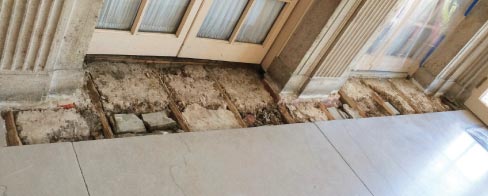 “At the end, to be able to walk through and hear those ‘wows,’ and see the fireworks going off in our client’s heads when they say, ‘This looks better than I imagined!’— this is what makes it all worthwhile,” said Mike Bivens. “And when the restoration fits within the aesthetic of the building and it looks like it never happened — I cannot say enough how fun and interesting that is. It’s where my passion comes from. Knowing that we went into a building that is in the historic register and we’ve restored it and made it look like it was when originally installed — it’s almost like bringing that history full circle. There are a lot of old monuments with a fascinating history, and that makes our job interesting. We are now a part of that history, and proud of it.”
“At the end, to be able to walk through and hear those ‘wows,’ and see the fireworks going off in our client’s heads when they say, ‘This looks better than I imagined!’— this is what makes it all worthwhile,” said Mike Bivens. “And when the restoration fits within the aesthetic of the building and it looks like it never happened — I cannot say enough how fun and interesting that is. It’s where my passion comes from. Knowing that we went into a building that is in the historic register and we’ve restored it and made it look like it was when originally installed — it’s almost like bringing that history full circle. There are a lot of old monuments with a fascinating history, and that makes our job interesting. We are now a part of that history, and proud of it.”
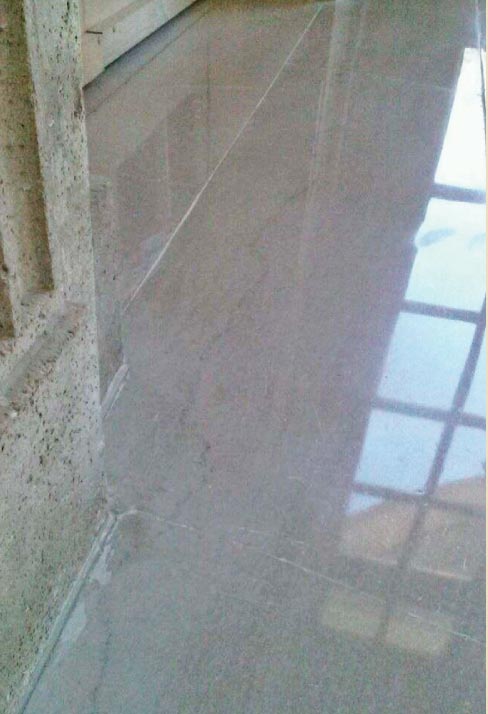 A small company with a ravenous appetite for large-scale work, The Marble Doctor, as of late, has finished three interesting projects: the Strathmore Mansion, a cultural centerpiece located in North Bethesda, Maryland; The United States Holocaust Museum, located in Washington, DC; and The Mount St. Sepulchre Franciscan Monastery, also located in Washington, DC. In Mike Bivens’ own words, the following three stories are brief accounts of those restorations.
A small company with a ravenous appetite for large-scale work, The Marble Doctor, as of late, has finished three interesting projects: the Strathmore Mansion, a cultural centerpiece located in North Bethesda, Maryland; The United States Holocaust Museum, located in Washington, DC; and The Mount St. Sepulchre Franciscan Monastery, also located in Washington, DC. In Mike Bivens’ own words, the following three stories are brief accounts of those restorations.
The Strathmore Mansion
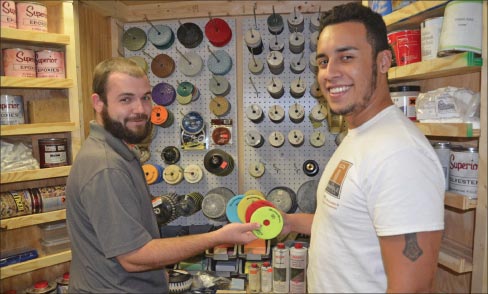 “The Strathmore Mansion, built in North Bethesda, Maryland in 1899, had been transformed into an art center in 1983. There’s a lot of marble in there that is original. There is also a big concert room that is original to the house. It has wood paneling up to about eight feet tall, and then twelve by twenty-four inch marble blocks line the top of the wood around the room. There are a lot of orchestral recordings done in this room, so the mansion is kind of a hub for the arts in the area. That room then leads into the foyer portion of the mansion, which has a marble statue in the center. The floor is composed of Tennessee marble slabs that were added after the building was built.
“The Strathmore Mansion, built in North Bethesda, Maryland in 1899, had been transformed into an art center in 1983. There’s a lot of marble in there that is original. There is also a big concert room that is original to the house. It has wood paneling up to about eight feet tall, and then twelve by twenty-four inch marble blocks line the top of the wood around the room. There are a lot of orchestral recordings done in this room, so the mansion is kind of a hub for the arts in the area. That room then leads into the foyer portion of the mansion, which has a marble statue in the center. The floor is composed of Tennessee marble slabs that were added after the building was built.
During events, such as weddings, caterers were using the room as a shortcut and the added stress from high traffic took its toll on the flooring. The slabs began cracking, especially in the doorways, so we were called in to take a look at it.
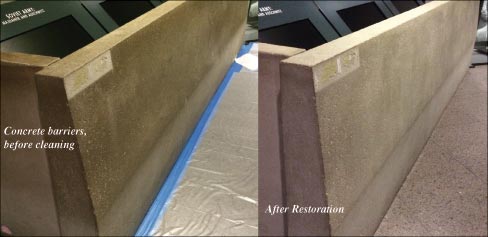 “In the past, while maintaining the floors, we had shown them the cracks, but they had declined any suggested repairs.
“In the past, while maintaining the floors, we had shown them the cracks, but they had declined any suggested repairs.
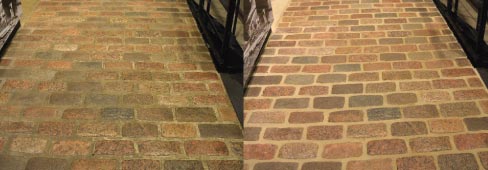 “But this time when they called us, they said the cracks are getting worse, and we need to do something about it.
“But this time when they called us, they said the cracks are getting worse, and we need to do something about it.
“When I got down to examine it closer, while pushing down on the slab, it acted like a bellows with dust and dirt coming out from underneath. The floor traffic had broken the plaster underneath that was used to fortify the space between the subfloor and joists, so there was a lot of movement in the floor. It was hollow and just going to get worse.
“After a closer examination, we decided some slabs were going to have to come out. The original installers had put fillers and metal sheeting in between the joists and subfloor to fortify it. The slabs were added after the house was originally built, and it was clear that the original installers had to lower the floor joists and subfloor so that the marble floor was even to the surrounding wood flooring. Later, after removing the slabs and examining the joists with the Mansion Historical Society, it was determined that the joists had to be hand-sawn to lower them down. Some marble slabs were thicker than others, and we knew we had to put a bedding down to compensate.
 “Before reinstalling the slabs, repairs on them were needed. One of the things required with this project was to put the damaged areas together using epoxy. We’ve got one guy who paints as a hobby and is really good with colors. Tennessee marble has a grey hue to it, but if you look closely it has some varying colors of grey spottiness in it, so it is very hard to recreate that while repairing with epoxies and resin pastes. What we did was use an old technique taking the reverse side of the slab, grinding off some of the material and mixing it with the epoxy instead of using dye to try to match the color. That was very effective. When we explained this technique to our client they were very intrigued. We then reinstalled the slabs and did a full restoration of the floor, removing any lippage while bringing it to a high polished shine.”
“Before reinstalling the slabs, repairs on them were needed. One of the things required with this project was to put the damaged areas together using epoxy. We’ve got one guy who paints as a hobby and is really good with colors. Tennessee marble has a grey hue to it, but if you look closely it has some varying colors of grey spottiness in it, so it is very hard to recreate that while repairing with epoxies and resin pastes. What we did was use an old technique taking the reverse side of the slab, grinding off some of the material and mixing it with the epoxy instead of using dye to try to match the color. That was very effective. When we explained this technique to our client they were very intrigued. We then reinstalled the slabs and did a full restoration of the floor, removing any lippage while bringing it to a high polished shine.”
People: The Heart and Soul of The Marble Doctor
Mike said, “We are a small company but we’ve been able to execute on some very high profile projects, and we like that. Everyone in the company is able to go into the field and do every kind of work, and that is something that every company needs. I wear many different hats, and so do our office manager and our technicians because we believe in what we do. One day I’m wearing a suit and pitching ideas, then the next day I’ve got my construction boots on and I’m out with the guys following their lead. We are willing to go out and do anything because it’s fun.”
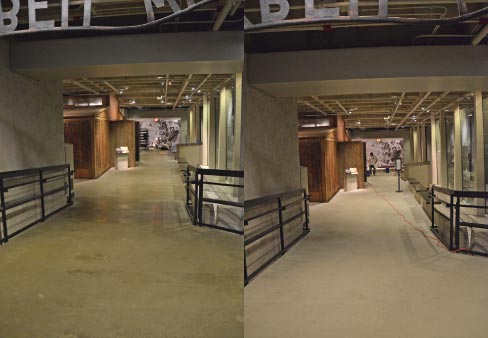 “Our two lead technicians have been with the company for almost a decade. I think that in our industry you can learn how to polish stone fairly quickly, but where you get the experience is running into problems, and that is what Jose Moreno and Jose Perez bring to the table. To this day, both of these guys will pull a trick out of their bag of goodies that I’ve never seen before, and it just amazes me. I’ll ask and they’ll simply say, ‘Seven years ago we had this same problem, and I remembered that this was the way we solved it.’
“Our two lead technicians have been with the company for almost a decade. I think that in our industry you can learn how to polish stone fairly quickly, but where you get the experience is running into problems, and that is what Jose Moreno and Jose Perez bring to the table. To this day, both of these guys will pull a trick out of their bag of goodies that I’ve never seen before, and it just amazes me. I’ll ask and they’ll simply say, ‘Seven years ago we had this same problem, and I remembered that this was the way we solved it.’
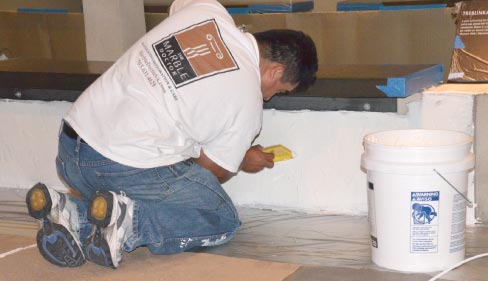 “There is always something to learn in this industry, and I don’t think we’ll ever get to the point where we can sit back and say we’ve done it all and nothing will ever challenge us again. I don’t see that. There is always something new to solve and those two guys are part of that collective way of thinking. They are a resource that is priceless. They also learned this process and way of thinking from our Founder, George Reed, who had worked very closely with Joseph Donatelli.
“There is always something to learn in this industry, and I don’t think we’ll ever get to the point where we can sit back and say we’ve done it all and nothing will ever challenge us again. I don’t see that. There is always something new to solve and those two guys are part of that collective way of thinking. They are a resource that is priceless. They also learned this process and way of thinking from our Founder, George Reed, who had worked very closely with Joseph Donatelli.
“Moreno and Perez do a lot of our training as well. They have a thirst for knowledge of this industry and are always looking to learn more. We’ve also got two younger guys that have joined our team recently. One of them was a tile setter for many years. He got bored with that and wanted to get into something new, and (restoration) intrigued him.”
The United States Holocaust Memorial Museum
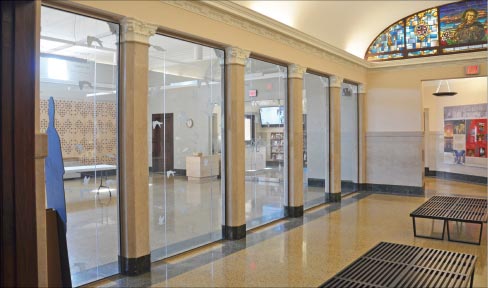 “The Testimony theatre is a large room in the Holocaust Museum in Washington DC. In the theatre, a continuous loop of stories from the survivors of the holocaust, and their testimonies and accounts of what they lived through is played. It is a place where people can go and almost live these stories. It’s a stadium type of theatre and it’s walls are made up of rough-cut Jerusalem Stone tiles that are made to resemble the twelve-by-twelve blocks (including drill marks) that enslaved workers had to carry up the side of a mountain on their backs and shoulders.
“The Testimony theatre is a large room in the Holocaust Museum in Washington DC. In the theatre, a continuous loop of stories from the survivors of the holocaust, and their testimonies and accounts of what they lived through is played. It is a place where people can go and almost live these stories. It’s a stadium type of theatre and it’s walls are made up of rough-cut Jerusalem Stone tiles that are made to resemble the twelve-by-twelve blocks (including drill marks) that enslaved workers had to carry up the side of a mountain on their backs and shoulders.
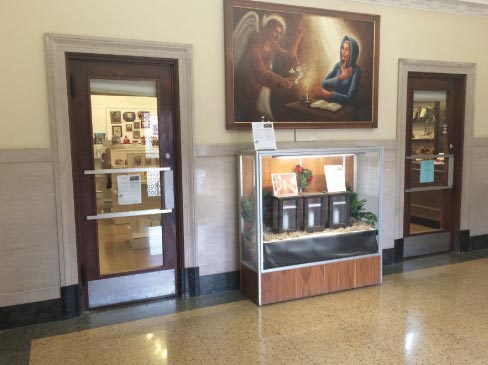 “The restoration originally began because the Polish Government, from what I understand, deemed a lot of the artifacts from the Holocaust as national monuments. Some of those items, including the barracks from Auschwitz that the museum had in its possession, had to be returned. The stone had never been maintained since the exhibit opened, and had 20 years of foot traffic and debris, so there was a lot of wear and tear on the floor. It was textured, so we couldn’t hone it. We used neutral pH stone cleaners and varying grit nylon bristle brushes to remove the dirt.
“The restoration originally began because the Polish Government, from what I understand, deemed a lot of the artifacts from the Holocaust as national monuments. Some of those items, including the barracks from Auschwitz that the museum had in its possession, had to be returned. The stone had never been maintained since the exhibit opened, and had 20 years of foot traffic and debris, so there was a lot of wear and tear on the floor. It was textured, so we couldn’t hone it. We used neutral pH stone cleaners and varying grit nylon bristle brushes to remove the dirt.
“Once it was clean, there were very distinct pink veins running through it, and the exhibitors were amazed to see this during our final walk through. They were so passionate about the building and we felt the same way. We were all very proud to be a part of it.”
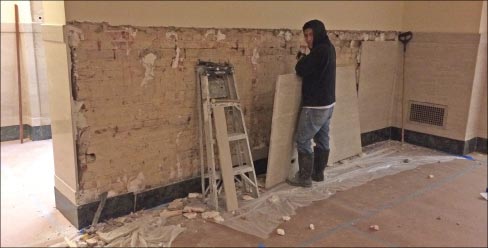 Mike continued, “There is a four story white marble wall on one side of the museum, and on the other side an equivalent size wall made of black granite. When we were getting ready to restore the (marble) wall they had some signage up, and when we removed them they found out what it originally looked like. There were also honed limestone dedication plaques out front that had a lot of environmental staining on them, and we restored them the best that we could.
Mike continued, “There is a four story white marble wall on one side of the museum, and on the other side an equivalent size wall made of black granite. When we were getting ready to restore the (marble) wall they had some signage up, and when we removed them they found out what it originally looked like. There were also honed limestone dedication plaques out front that had a lot of environmental staining on them, and we restored them the best that we could.
“We also cleaned granite cobblestones that had been removed from the streets of Warsaw. Those cobblestones had a lot of significance. Originally, before we cleaned them, it was thought that they were just bricks, but afterwards we realized they were granite blocks. Amazingly, they were returned to their original condition and all work for the museum was completed per contract.
“In that contract they additionally wanted some maintenance options. The building has a very defined traffic pattern, and it had been so long since they had done anything to it. They now wanted it to continue to look good. We gave them options for continued maintenance and they asked us to be available six months, a year, and then eighteen months because they weren’t sure at what point they should invoke that maintenance to keep it looking like they wanted. So in a sense, it is still an ongoing project.”
Techniques Old and New
Reusing the original material instead of a remake is always the target of The Marble Doctors. “We are very careful in the use of chemicals, and that is very hard to do with old buildings that have facades loaded with contaminants. We don’t like to use pressure washing that compacts or pushes in those contaminants. We do use a lot of different poultices with additives, instead.
“A latex poultice is one that was very instrumental during the restoration of the Holocaust Museum because of its ability to be removed quickly, thereby allowing the museum to remain open while we were working. That was critical. This kind of work many times requires us to work after-hours shifts. Many of our guys like to work those shifts because no one is in their way.
“Sometimes we also use tents to seal off the work areas. That can get a little dicey when people come walking through and our guys are running machines. If we do work in our shop, we use the same tools (hand saws, wet polishers, etc.) that would be used in the field. Large jobs, requiring extensive fabrication, are sent to a variety of local fabrication shops—mostly smaller ones where we can have a little more involvement, during the process. If needed, we’ll source the granite and have it sent to a specific fabricator and then we’ll install it. If we have to do a replacement of material that was quarried many years ago we will search through a lot of places. We do have access to exotic stones overseas and (have) worked with a specific person when we needed something specific or difficult to find stateside.
“As far as historical stone, we do our best to utilize the material that is already there, so there isn’t the need for new. It is so difficult to match old marble and granite. That said, we will go to great lengths to match material when we have to, but there is no guarantee. We then involve the customer in the process of choosing new material. We’ll use the original plans and renderings when available to aid in the identification and source of the material to find the exact name and where it came from, and start the process of hunting for the same marble.”
The Mount St. Sepulchre Monastery
One recent high-profile project for The Marble Doctor was a Franciscan Monastery near Washington D.C. “We worked with a general contractor on this project, and the Monastery insisted on us for the job because of our very long relationship with the monastery (See slipperyrockgazette.net Archives: A Franciscan Monastery, a Marble Doctor, and Fate, November 2013). There are a lot of nice people there who really understand and have an affinity for the history of that building.
“Handicap accessibility was a major upgrade to the Monastery, and they wanted it to look like it was always there, and not recently done. Originally they were expecting it to go a little faster, but once we got going it was realized that not everything was up to existing code, so once work was underway we had to get creative to keep the project in line with the historical guidelines.
“We had to do the demo first, categorizing all removed pieces and their location. In removing those slabs the general contractor came back to us and said, ‘You know, I don’t understand where you’re at.’ The architect was also under the impression that the removal of this marble would be quick and simple and should just come right off the wall, but it’s not always that easy.
“Because of the age we knew how those panels were put on the wall, so we walked them through what was expected on the other side of the wall and explained that we were going to remove, categorize, and store them in a shed in the back with other stone (altars and other ornate pieces) from years gone by. In their minds we were just putting a hole in the wall, and just moving the marble out of the way.
“Conversely, our thought was that this marble was specific to this building and installed by the original artisans. We want to take it down and save it in full pieces for the monastery, so if at any point when they want to do an addition and the marble needs to match the existing, then they will have it.
“There was also a doorway where the handicap ramp was going to be installed. All of the marble cornices and panels that we removed were also saved for the future.
“Marble quarried today is not going to match that which was quarried in the 1800s, so I had to explain how important every piece was. They then said, ‘But this is just a demo job,’ and I said, ‘This is not a demo job—it is a historical preservation and every one of these pieces is very important.’ So the Brothers at the monastery went to bat for us and told them, ‘Hey look! These are the only people who work on our marble and whatever they say goes.’ Everyone finally realized that we had the same affinity for the building that the Monks do.
“The next step was on-site re-fabrication of the existing pieces, and then re-installing them to look as if they had existed there since the building was originally built. There were a lot of wall slabs that had cracked and had degradation of the veins from being there so long. It was almost like Crema Marfil in that after time the veining may show or crack, so we did have to take a lot of care when removing them.
“Later, when one of the electricians got above the ceiling, he called me over and said, ‘You gotta see what’s up here!’ We had gone up into the ceiling and looked, and there were hidden marble capitals (the uppermost portion of a column, usually shaped to articulate the joint with a lintel or arch supported). The newer capitals that were visible from below the ceiling were made out of plaster and were faux painted. Everyone thought they were marble! The real marble capitals that were above were twice the size of the plaster ones.
“So it was clear that at some point in the past the ceiling height was lowered and these huge ornate marble capitals were replaced with plaster ones at a lower height. That was another interesting thing we discovered when the layers were peeled back. We also had to restore the terrazzo flooring throughout the main lobby, visitors lobby and attached vestibules. There are quite a few people that live and work in the building, so a couple of times we had to remind all concerned that we are in their house and to be careful what you do and say. It is a church, after all! The project took three months from demo to completion.”
The Future
“Moving forward, we are looking to get into bigger projects, but slowly. We like to take the time to do the right thing. We are looking to expand and hire new people while looking for more challenges with history, and that’s enough to keep our mouths watering for more, more, more. At the same time, however, we want to keep an eye on quality, making sure that we’re not growing at the sacrifice of that quality. We want to grow at a slow rate so we have that control. We are very selective and won’t hire someone just to have a warm body. We look at it long-term, and we are going to fill their heads with knowledge of what we do and what we’ve done. I am so proud of our people and to be part of the team that we have here. What these guys can do on a day-to-day basis that is above and beyond is unparalleled with anything I have ever seen in my entire life.
“In the world today there is a faster pace, but when it comes to historical restoration you want efficiency but don’t want to make hasty decisions because of time constraints. That is something I tell our customers. It’s not because we are slow or lazy—it’s because we want to make very sure that what we are doing is precisely what should be done. That insures that what we are doing is of the highest quality for our customers. That is what makes us who we are. I’m really excited about what the future holds for us, even in just the next year.”
The Mount St. Sepulchre Franciscan Monastery is located in the Brookland neighborhood of Northeast Washington, D.C. For more information on The Marble Doctors visit their website www.marbledoctorva.com.
